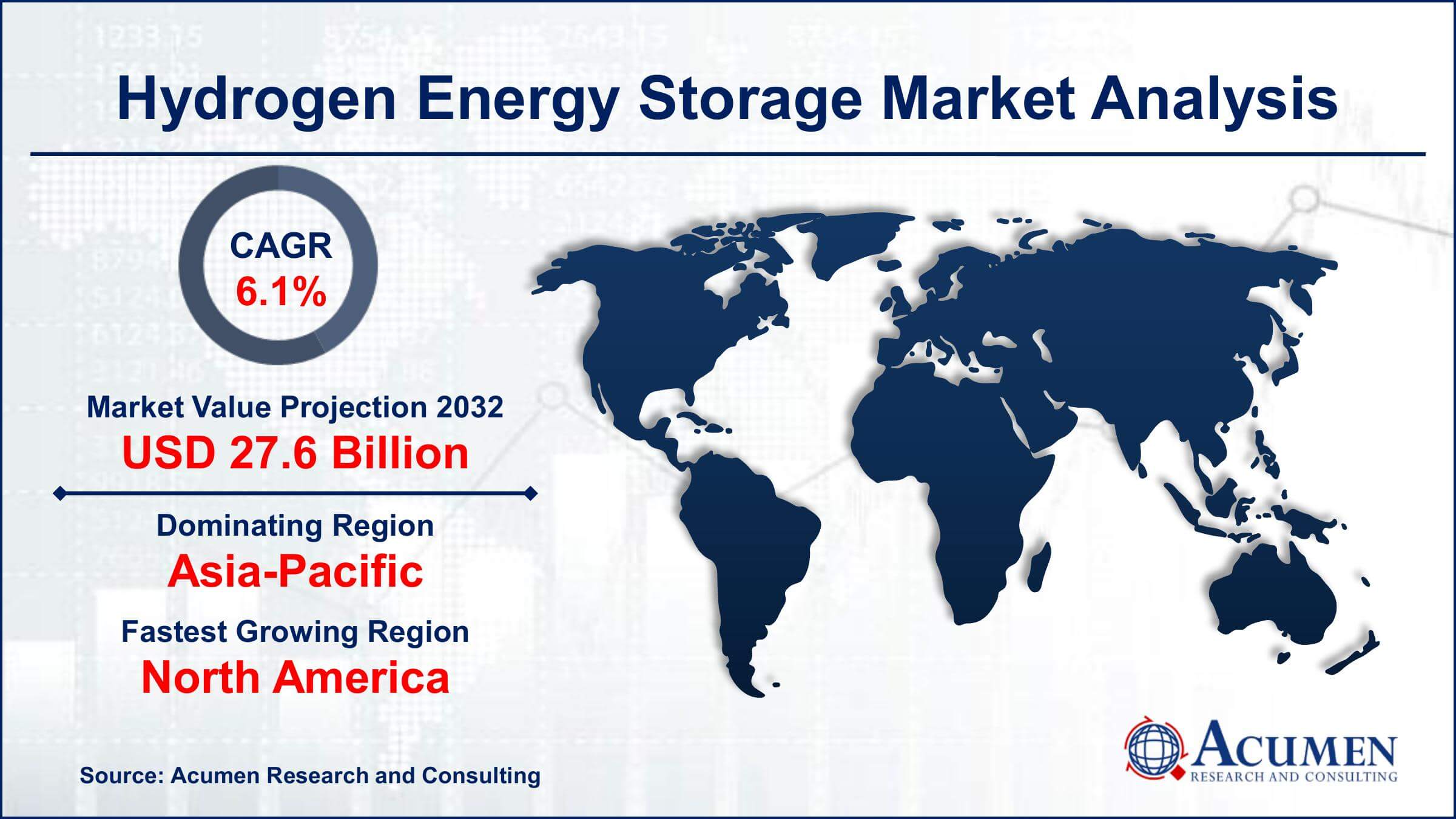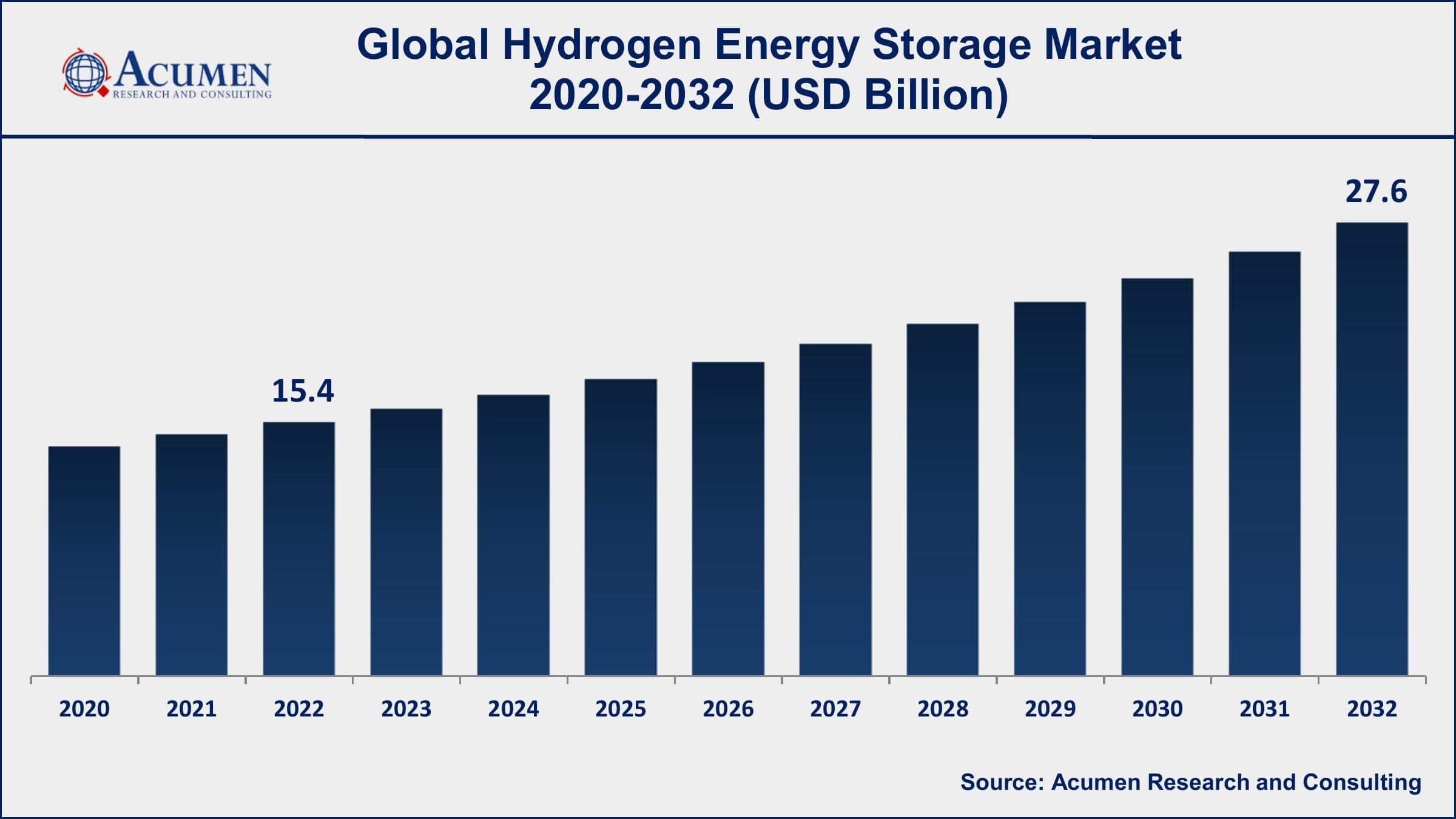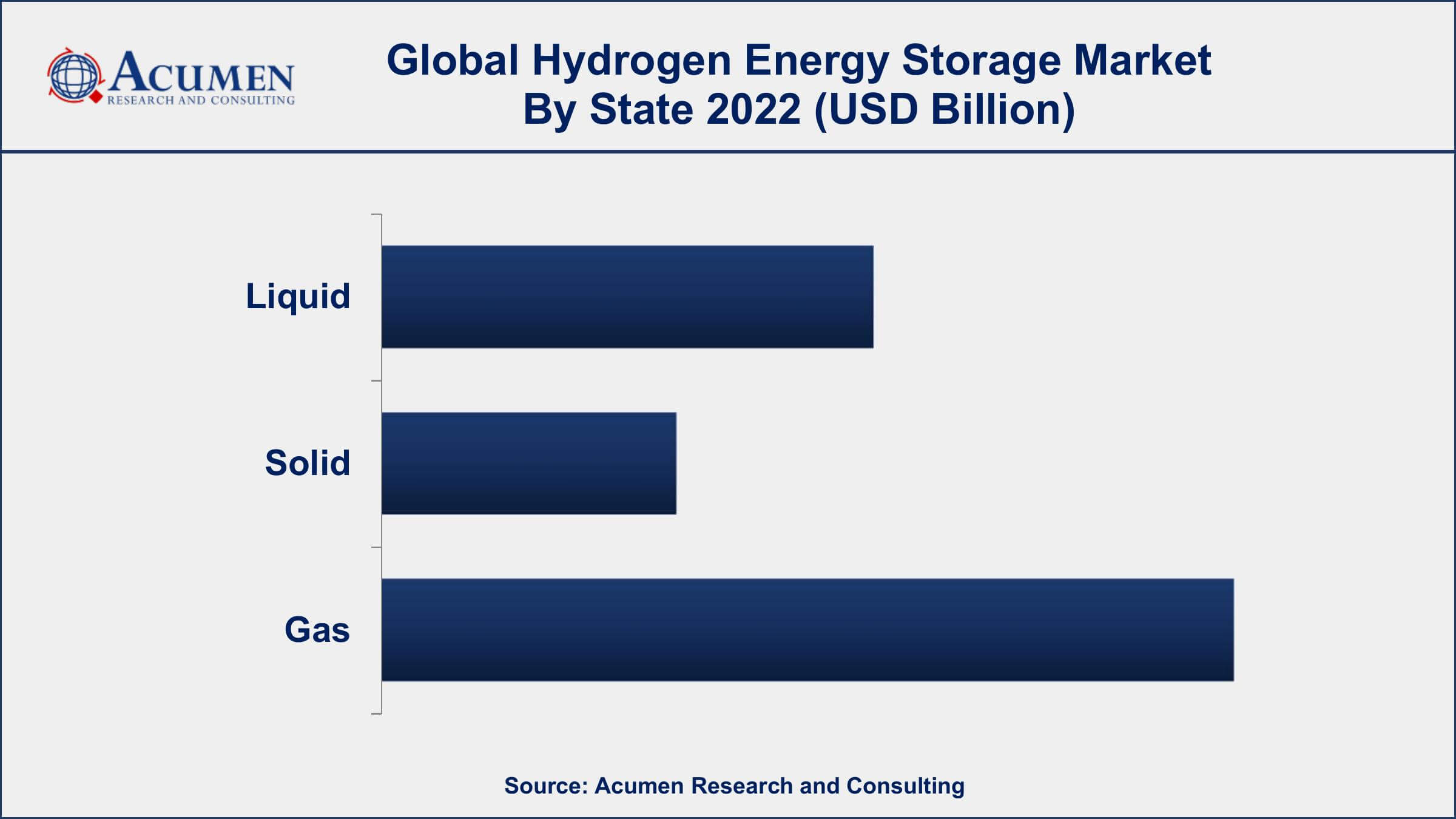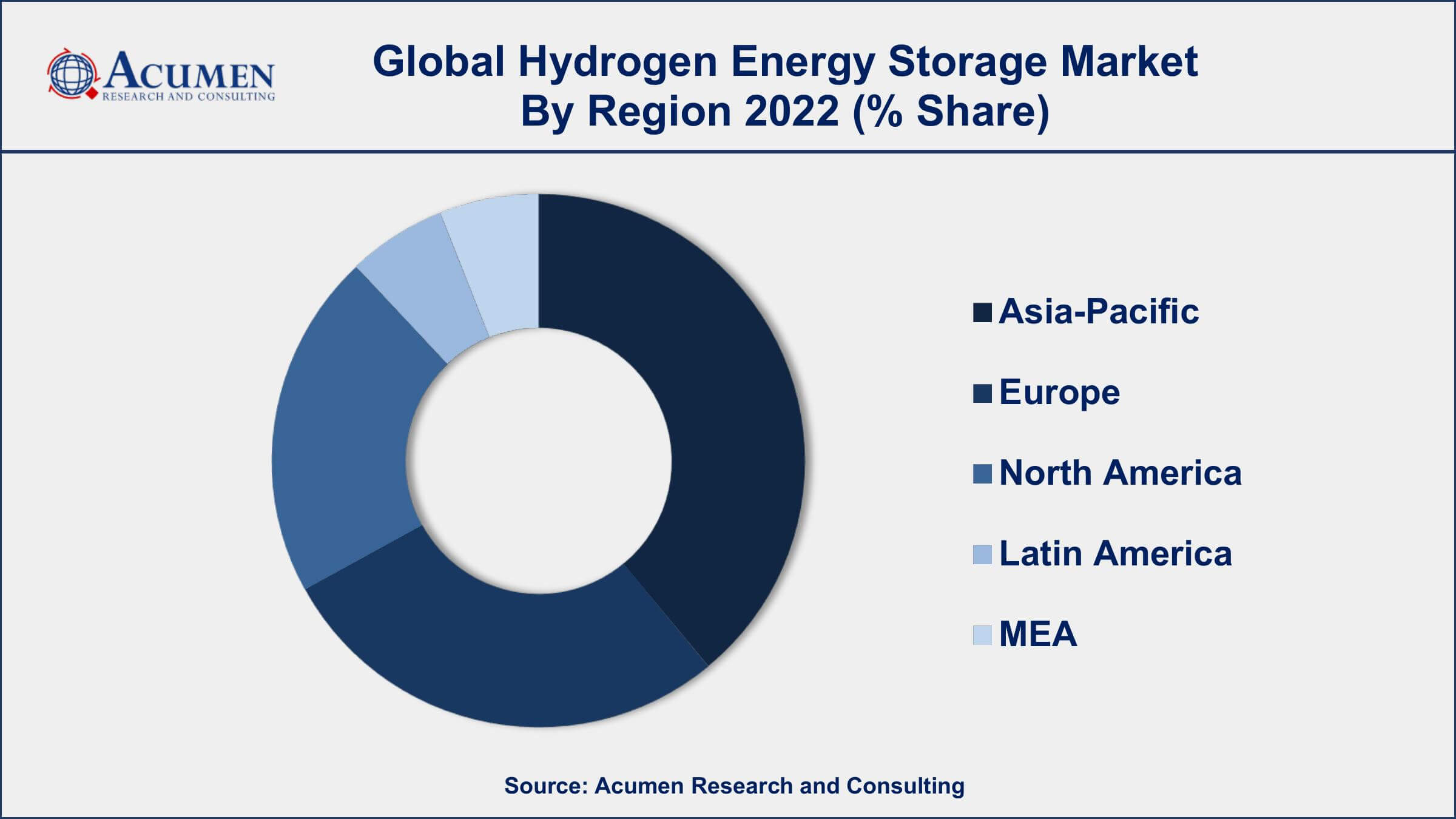March 2023
Hydrogen Energy Storage Market (By State: Liquid, Solid, Gas; By Storage Technology: Compression, Liquefaction, Material Based; By End-user: Industrial, Commercial, Utility) - Global Industry Size, Share, Analysis, Trends and Forecast 2023 - 2032
The Global Hydrogen Energy Storage Market Size accounted for USD 15.4 Billion in 2022 and is projected to achieve a market size of USD 27.6 Billion by 2032 growing at a CAGR of 6.1% from 2023 to 2032.

Hydrogen energy storage is the process of storing energy by converting electricity into hydrogen, which can then be stored in a tank or pipeline for later use. When the stored hydrogen is needed, it can be converted back into electricity through a fuel cell or combustion process, providing a source of clean and efficient energy. This technology has the potential to play a critical role in the transition to a more sustainable energy system, by enabling the integration of renewable energy sources such as solar and wind power into the grid.
The market for hydrogen energy storage has been experiencing significant growth in recent years, driven by a range of factors including increasing demand for clean energy, government incentives and subsidies, and technological advancements. While the market for hydrogen energy storage is still in its early stages, there are signs that it is poised for significant growth in the coming years. As the world continues to shift towards a more sustainable energy system, hydrogen energy storage is likely to play an increasingly important role, providing a versatile and scalable solution for storing renewable energy and reducing carbon emissions.

| Market | Hydrogen Energy Storage Market |
| Hydrogen Energy Storage Market Size 2022 | USD 15.4 Billion |
| Hydrogen Energy Storage Market Forecast 2032 | USD 27.6 Billion |
| Hydrogen Energy Storage Market CAGR During 2023 - 2032 | 6.1% |
| Hydrogen Energy Storage Market Analysis Period | 2020 - 2032 |
| Hydrogen Energy Storage Market Base Year | 2022 |
| Hydrogen Energy Storage Market Forecast Data | 2023 - 2032 |
| Segments Covered | By State, By Storage Technology, By End-user, And By Geography |
| Regional Scope | North America, Europe, Asia Pacific, Latin America, and Middle East & Africa |
| Key Companies Profiled | Air Liquide, Ballard Power Systems, Cummins Inc., Doosan Fuel Cell, FuelCell Energy, Hydrogenics Corporation, ITM Power, Linde plc, McPhy Energy, Nel Hydrogen, Plug Power, and Siemens Energy. |
| Report Coverage |
Market Trends, Drivers, Restraints, Competitive Analysis, Player Profiling, Covid-19 Analysis, Regulation Analysis |
Hydrogen is considered to be a critical energy storage vector for fully utilizing the benefits of renewable and sustainable energy. Hydrogen-related technologies have advanced rapidly in recent decades. Hydrogen energy storage systems provide numerous opportunities for improving the resilience and economics of energy supply systems such as the electric grid, gas pipeline systems, and transportation fuels. This is especially true when considering specific social goals and market drivers such as lowering carbon emissions, increasing supply reliability, and reducing consumption of traditional petroleum fuels.
Hydrogen and energy have a long history together, dating back over 200 years to the first internal combustion engines and continuing to become a critical component of today's refining industry. It is lightweight, storable, and energy-dense, with no direct pollutant or greenhouse gas emissions. Hydrogen must be adopted in sectors where it is currently almost non-existent, such as transportation, buildings, and power generation, to make a significant contribution to clean energy transitions. When hydrogen is combusted with oxygen, it becomes an energy carrier that can be used in internal combustion engines or fuel cells while emitting almost no greenhouse gases. Water vapor is the only significant emission. Furthermore, hydrogen is a versatile energy carrier that can be produced from a variety of energy sources and provides numerous opportunities for long-term energy storage.
The global hydrogen energy storage market segmentation is based on state, storage technology, end-user, and geography.

Based on the state, hydrogen is stored into either a gas or a liquid form. The gas-type hydrogen energy storage segment presently holds a significant market share and is expected to hold its dominant position over the forecast period as it is the easiest and most cost-effective method compared with the liquefaction of hydrogen. However, the storage of hydrogen as a gas typically necessitates the use of high-pressure tanks with tank pressures ranging from 350–700 bar [5,000–10,000 psi].
Based on the storage technology, the compression segment is the most preferred technology for storing hydrogen. The main advantage of using a compressed hydrogen storage system is the ability to quickly refuel vehicles in 3–5 minutes. In recent, 35 and 70 MPa nominal working-pressure compressed gas vessels are used for onboard automotive hydrogen storage. Given that the density of hydrogen deviates from ideal behavior at high pressures and increases much more slowly than the pressure, strong pressure vessels are required to withstand the higher pressures. Government agencies regulate the design and implementation of cylinders, which necessitates specific design standards and certifications.
According to the hydrogen energy storage market forecast, the utility segment is expected to grow significantly during the forecasting years. Due to hydrogen, utilities could use excess renewable energy that could be stored long-term for seasonal use or sold to other industries to generate new revenue streams. Furthermore, hydrogen is currently used in a variety of industries, ranging from chemical and refining to metallurgical, glass, and electronics. The primary application of hydrogen is as a reactant. However, it is also used as a fuel in space applications, as an O2 scavenger in metal heat treatment, and for its low viscosity and density.
North America
Europe
Asia-Pacific
Latin America
The Middle East & Africa

Asia-Pacific accounted for the highest revenue share in the global hydrogen energy storage market in 2022, owing to the impact of productivity improvements. The Asia-Pacific’s emerging economies are adopting a variety of foreign equipment to increase production efficiency for hydrogen storage. Japan has the most hydrogen fuel stations per capita in the world. There were around 134 operational hydrogen refueling stations in the country as of March 2021 and the country aims to construct over 1,000 more hydrogen refueling stations for fuel-cell vehicles by 2030. During the forecast period, the North America hydrogen energy storage market is expected to grow at a significant CAGR. The rise in fuel cell applications, strict emission control regulations, and the use of cleaner fuels are the major factors driving the regional hydrogen energy storage market growth. In the US, the United States Department of Energy (US DOE) had set specific targets for respective market participants in the automotive industry to focus on research and development with an objective to boost successful technical research on hydrogen storage.
Some of the top hydrogen energy storage market companies offered in the professional report include Air Liquide, Ballard Power Systems, Cummins Inc., Doosan Fuel Cell, FuelCell Energy, Hydrogenics Corporation, ITM Power, Linde plc, McPhy Energy, Nel Hydrogen, Plug Power, and Siemens Energy.
Looking for discounts, bulk pricing, or custom solutions? Contact us today at sales@acumenresearchandconsulting.com
March 2023
March 2024
January 2021
July 2023